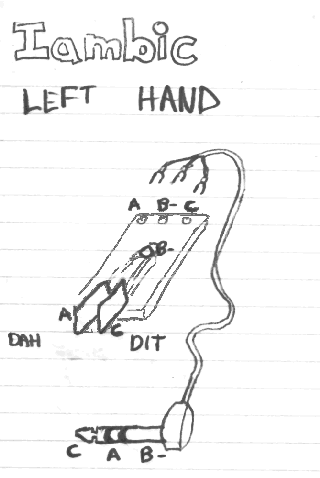Also known as Iambic Paddles, or Iambic Key.
An iambic keyer consists of two separately actuated switches. Iambic operation is useful for sending characters that have alternating patterns such as a period or the letter C. The "iambic" function is created with an electronic keyer by squeezing the paddles together. The squeezing produces alternating dits and dahs similar to a sequence of iambs in poetry, which is where it gets its name.
- dit (.) refers to short and dah (-) refers to long
Although a single paddle keyer also utilizes separate contacts for dits and dahs, there is no ability to make both contacts simultaneously by squeezing the paddles together. Iambic keying by squeezing the paddles together creates alternating dits and dahs. This is supposed to increase speed and create a convenience or ease in sending cw. For sending Morse at speeds greater than 20 to 30 wpm the straight key becomes impractical. The iambic key becomes one viable option for the speed keyer.
Right or Left Hand Key
Most right handed people use their right hand on the paddles. The THUMB is always used to send the dit and the INDEX FINGER for dah.
- Right Hand Keyer - left paddle (thumb) is the dit / pushes right
- Left Hand Keyer - right paddle (thumb) is the dit / pushes left
The example is the less common lefty configuration. Reverse wires (A) and (C) for the more common right hand operation.
Mode A and B
Mode A and B refer to the way that a Morse code keyer handles iambic (squeeze) keying so first, let’s define iambic keyer operation. An iambic keyer will send an alternating sequence of dits and dahs as long as both the dit and dah switches are depressed or squeezed.
The difference between mode A and B lies in what the keyer does when both paddles are released. The mode A keyer completes the element being sent when the paddles are released. The mode B keyer sends an additional element opposite to the one being sent when the paddles are released.
You can tell the basic difference between the modes with the letter C. In mode A you could squeeze both paddles (dah before dit) and you would let go of both after hearing the last dit. With mode B, you start the same BUT let go of both paddles after hearing the second *dah*.
Slap Keying
Single lever keying with a bug is sometimes called slap keying since you can only depress either the dit (slap to the right) or dah (slap to the left). If you use a dual lever keyer such as an Iambic keyer only slapping to the left or right, then you are slap keying. This is fine, however, it does not utilize the "iambic" functionality of the key.
Simply put, if you don't squeeze the dual lever paddle then it will work just like a single lever paddle.
The single paddle keyer is called a bug, which is mentioned above. Users of the bug tend to use a slapping action, also mentioned above. However, those learning to use an iambic paddle are encouraged not to slap the paddles. Just a light touch is all it takes if you have it adjusted correctly. If the paddle moves around the table while you are sending then you are using too much force.[[Category:Radio]
